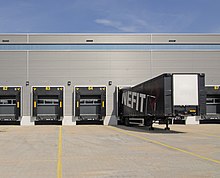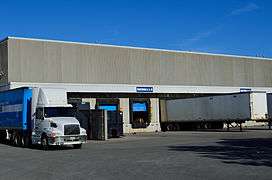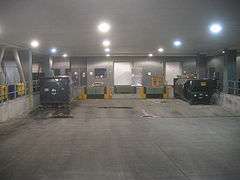Loading dock
A loading dock or loading bay is an area of a building where goods vehicles (usually road or rail) are loaded and unloaded. They are commonly found on commercial and industrial buildings, and warehouses in particular. Loading docks are part of a facility's service or utility infrastructure, typically providing direct access to staging areas, storage rooms, and freight elevators.[1]


Basics
In order to facilitate material handling, loading docks may be equipped with the following:
- Bumpers – protect the dock from truck damage, may also be used as a guide by the truck driver when backing up.[1]
- Dock leveler – a height-adjustable platform used as a bridge between dock and truck, can be operated via mechanical (spring), hydraulic, or air powered systems.[1]
- Dock seals or dock shelters – compressible foam blocks against which the truck presses when parked; seals are used at exterior truck bays in colder climates where this will provide protection from the weather.[1]
- Dock light – a movable articulating light mounted inside the dock used to provide lighting inside the truck during loading operations.[1]
In North America, the most common dock height is 55 inches (140 cm). A dock leveler bridges the gap between a truck and a warehouse to safely accommodate a forklift.[1]
Loading zone
In different parts of the world, a section of a public or private road may be allocated for loading goods or persons, at specific or at all times. There are parking signs and/or road markings to warn motorists of parking regulations. These areas are known as loading zones or loading bays in many jurisdictions. They are generally monitored by parking inspectors, and vehicles found to be violating the rules can be towed or fined.[2][3]
 Typical warehouse exterior showing loading docks
Typical warehouse exterior showing loading docks An interior loading dock at the New Research Building, Harvard Medical School
An interior loading dock at the New Research Building, Harvard Medical School A reinforced concrete loading dock under construction
A reinforced concrete loading dock under construction
Dock Leveler Safety Requirements
OSHA Walking-Working Surfaces standard, which includes below guidelines:[4]
- 29 CFR 1910.30(a)(1) Portable and powered dock boards shall be strong enough to carry the load imposed on them
- 29 CFR 1910.30(a)(2) Portable dock boards shall be secured in position, either by being anchored or equipped with devices which prevent their slipping
- 29 CFR 1910.30(a)(3) Powered dock boards shall be designed and constructed in accordance with Commercial Standard CS202-56 (1961) "Industrial Lifts and Hinged Loading Ramps" published by the U.S. Department of Commerce, which is incorporated by reference as specified in Sec. 1910.6.
- 29 CFR 1910.30(a)(4) Handholds, or other effective means, shall be provided on portable dockboards to permit safe handling
- 29 CFR 1910.30(a)(5) Positive protection shall be provided to prevent railroad cars from being moved while dockboards or bridge plates are in position
- 29 CFR 1910.178(k)(4) Positive protection shall be provided to prevent railroad cars from being moved while dockboards or bridge plates are in position.
References
- Sophia Greenbaum. "Whole Building Design Guide: Loading Dock". National Institute of Building Sciences. Retrieved 2008-02-26.
- Archived November 11, 2013, at the Wayback Machine
- Archived February 28, 2014, at the Wayback Machine
- 29 CFR 1910.30(a)
External links

- Loading Dock Equipment Manufacturers (LODEM)